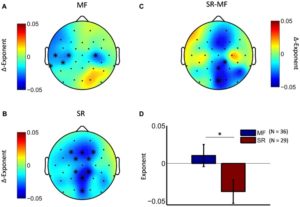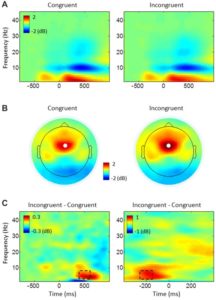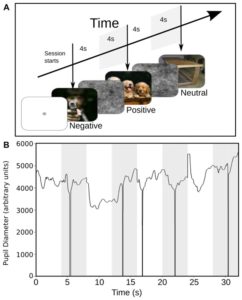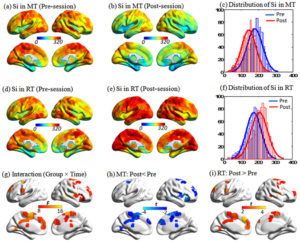Reduce Psychotic Symptoms with Meditation
By John M. de Castro, Ph.D.
“While meditating the last day I finally could see love as an underlying force in the universe, and I had a waking dream of some fractal patterns realigning, it is hard to describe with words. It is still embarrassing to remember all the details of this, but it can be summarized with one word: delirium. I was totally out of myself, and what is worse, I was acting in inappropriate ways with other people. For instance, I was being hosted by a girl, and I acted violently smashing a cup against a wall, and throwing a chair to the floor. I still remember how my mind was watching in horror how my body was acting. It was stuff for nightmares…” – TLDR
There have been a number of reports that mindfulness meditation can lead to psychotic like symptoms in a few individuals. This appears to be amplified by participation in meditation retreats. It has been reported that around 60% of participants in intensive meditation retreats experienced at least one negative side effect, including panic, depression and confusion and about 7% experienced psychotic-like symptoms. Hence, meditation, although highly beneficial, does have some potential negative effects for many people and extreme negative consequences for a few.
There has, unfortunately been very little research on these negative effects of meditation. In today’s Research News article “Schizotypy and mindfulness: Magical thinking without suspiciousness characterizes mindfulness meditators.” See summary below or view the full text of the study at: https://www.ncbi.nlm.nih.gov/pmc/articles/PMC5514306/, Antonova and colleagues, to address this issue, examine whether psychotic like symptoms are present in experienced meditators. They recruited male meditators who have been consistently practicing over at least 2 years, meditating at least 6 days per week for at least 45 minutes per day and males who had never practiced meditation and any other mindfulness practice. The participants were measured for five facets of mindfulness, including describing, observing, acting with awareness, non-judging, and non-reacting, and schizotypal personality characteristics, including ideas of reference, excessive social anxiety, magical thinking, unusual perceptual experiences, odd/eccentric behavior, no close friends, odd speech, constricted affect and suspiciousness.
They found that meditators had significantly lower scores on suspiciousness and excessive social anxiety, and higher scores on magical thinking. They were also higher in mindfulness, including observing, non-judging, and non-reacting. In addition, the higher the scores on acting with awareness and non-judging, the lower the levels of schizotypal personality characteristics including suspiciousness, excessive social anxiety, and constricted affect (blunted emotions). Hence, experienced meditators tend to have fewer psychotic-like symptoms and higher mindfulness and high levels of mindfulness were associated with lower psychotic-like symptoms.
These results are interesting and tend to counter the notion that meditation is associated with increased negative psychotic-like symptoms. This may be due, though, to the fact that people who meditate consistently over a long period of time are generally psychological healthy individuals to begin with. It is also possible that those individuals who are sensitive of the negative effects of meditation simply drop out and don’t continue meditating as the negative consequences present themselves. The higher levels of magical thinking in the meditators may result from the fact that the meditators all practiced in the Buddhist tradition where metaphysical ideas are taught.
This is an important line of research and could be best addressed with longitudinal research investigating beginning meditators and following their progress over an extended period of time. Unfortunately, the present results do not provide a clearer understanding of the potential hazards of meditation practice, particularly while engaging in meditation retreats. Perhaps research that closely follows meditators while participating in a retreat may help to elucidate the factors responsible for the reported negative consequences.
So, reduce psychotic symptoms with meditation.
“60 per cent of people who had been on a meditation retreat had suffered at least one negative side effect, including panic, depression and confusion, a study in the US found.” – Harriett Crawford
CMCS – Center for Mindfulness and Contemplative Studies
This and other Contemplative Studies posts are also available on Google+ https://plus.google.com/106784388191201299496/posts and on Twitter @MindfulResearch
Study Summary
Antonova, E., Amaratunga, K., Wright, B., Ettinger, U., & Kumari, V. (2016). Schizotypy and mindfulness: Magical thinking without suspiciousness characterizes mindfulness meditators. Schizophrenia Research: Cognition, 5, 1–6. http://doi.org/10.1016/j.scog.2016.05.001
Abstract
Despite growing evidence for demonstrated efficacy of mindfulness in various disorders, there is a continuous concern about the relationship between mindfulness practice and psychosis. As schizotypy is part of the psychosis spectrum, we examined the relationship between long-term mindfulness practice and schizotypy in two independent studies. Study 1 included 24 experienced mindfulness practitioners (19 males) from the Buddhist tradition (meditators) and 24 meditation-naïve individuals (all males). Study 2 consisted of 28 meditators and 28 meditation-naïve individuals (all males). All participants completed the Schizotypal Personality Questionnaire (Raine, 1991), a self-report scale containing 9 subscales (ideas of reference, excessive social anxiety, magical thinking, unusual perceptual experiences, odd/eccentric behavior, no close friends, odd speech, constricted affect, suspiciousness). Participants of study 2 also completed the Five-Facet Mindfulness Questionnaire which assesses observing (Observe), describing (Describe), acting with awareness (Awareness), non-judging of (Non-judgment) and non-reactivity to inner experience (Non-reactivity) facets of trait mindfulness. In both studies, meditators scored significantly lower on suspiciousness and higher on magical thinking compared to meditation-naïve individuals and showed a trend towards lower scores on excessive social anxiety. Excessive social anxiety correlated negatively with Awareness and Non-judgment; and suspiciousness with Awareness, Non-judgment and Non-reactivity facets across both groups. The two groups did not differ in their total schizotypy score. We conclude that mindfulness practice is not associated with an overall increase in schizotypal traits. Instead, the pattern suggests that mindfulness meditation, particularly with an emphasis on the Awareness, Non-judgment and Non-reactivity aspects, may help to reduce suspiciousness and excessive social anxiety.









